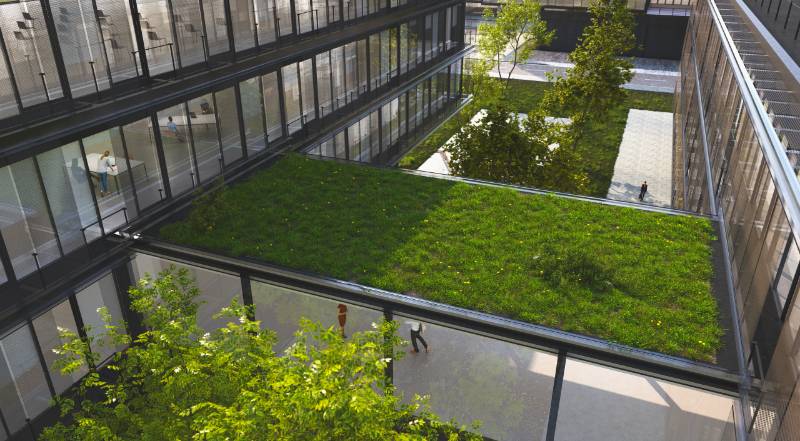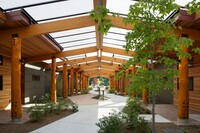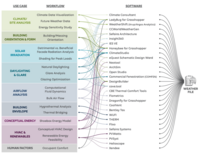Championing the
Changemakers
BuildingGreen champions the changemakers in sustainable design and building, with trusted insight, unparalleled education, and communities that are transforming the industry.
Log in to your profile

Image: Piranka

Webcast
Should housing be affordable? Or should it be sustainably designed, built, and operated?
When you put it like that, the question sounds absurd.
But the idea—usually unspoken—that sustainability wastes precious time and resources is painfully common in the affordable housing world.
It’s time to bust that myth. In this... Read more
Spotlight Report
Experts agree: it is possible to build both sustainably and affordably.
But to do so, we must shift our business-as-usual approach by applying systems thinking and centering equity in sustainable design. After all, a building is only “green” if its entire supply chain is too.
So what does this... Read more
Feature
Sustainability doesn’t have to cost more—and no one knows that better than affordable housing experts. But every project type can benefit from these 12 cost-reducing ideas that support people and the planet.
This is Part Two of a two-part series related to affordable housing. It supports project teams across disciplines and building typologies with 12 specific ideas for building green on a budget. Part One emphasizes the critical importance of sustainability in affordable housing and details six steps building professionals can take to help that... Read more
Product Guide
Air-to-air heat pumps transfer heat energy from the air into and out of a building. These systems have an outdoor unit with a compressor and condenser, and either indoor units or a central... Read more
Spotlight Report
As we work to provide affordable shelter to tens of millions of households in the U.S., we have a choice: we can reinforce the exploitive systems that created our housing crisis, or we can support health, life, and resilience.
But the perceived first cost of sustainable and regenerative design solutions is one of the... Read more
Feature
The U.S. is grappling with a housing crisis, climate change, and a legacy of racism and segregation. But we can address these problems all at once by centering community.
This is Part One of a two-part series related to affordable housing. It emphasizes the critical importance of sustainability in affordable housing and details six steps building professionals can take to help that happen. Part Two supports project teams across disciplines and building typologies with 12 specific ideas for building green on a... Read more
Product Guide
HPWHs are more than three times more efficient than standard water heaters, and those that use CO2 as a refrigerant are the best.
Note: This guide does not include information on boilers or air-to-water heat pumps used in larger commercial applications, though some HPWH systems are modular and can sometimes meet those demands.
... Read more
Product Review
Intellihot electrifies commercial water heating using heat pumps, CO2 refrigerant, thermal batteries, and no need for water storage.
The commercial water-heating systems used in hotels, restaurants, and large multifamily buildings have a few problems. As we move toward all-electric buildings, we need an alternative to gas, but heat-pump water heaters face a couple of challenges:
First, they do not heat water very quickly. For this reason, they require storage tanks... Read moreWebcast
Wood products are widely considered to be inherently “carbon neutral.” The current surge of interest in mass timber was spurred by this belief.
But could scaling up our demand for wood actually make climate change worse?
It’s a huge risk. Our forests are a massive carbon bank and a critical climate buffer,... Read more
News Analysis
Weather files that help designers plan for climate change will soon be readily available. ASHRAE design conditions still lag.
This article has been prepared for informational purposes only; it is not intended to provide, and should not be relied on for, legal advice.
Architects and engineers are required to help their clients plan for climate change, but standard energy modeling practice and design standards are based on weather histories that are often over... Read more
Blog Post
Now is your chance to comment on LEED version 5, a pivotal update and the first major change since 2013. We give you the highlights below.
By Nadav Malin and Paula Melton
It’s here. So what’s new?
The U.S. Green Building Council (USGBC) released LEED v5 for its first public comment period on April 3, 2024, giving us our first detailed look at the next generation of the program that has defined green building in North America and around the world for more than... Read more
April Fools
GSHPs have gone mainstream, thanks to the Inflation Reduction Act, and the hippest AEC professionals are so over them.
“I was specifying ground-source heat pumps before they were popular,” recalled Gea Snootfeld, principal at Seattle’s Maverick Design. “Most people installing them now don’t, like, actually, get it.”
Snootfeld is referring, of course, to the recent breakout of ground-source heat pumps (GSHPs) onto the mechanical heating and cooling... Read more
April Fools
A building project brings brothers back together, but a fast-moving storm challenges the project and the family.
Welcome to the second installment of BuildingGreen’s Biophilic Design series “Built Against the Howling Wind,” as we follow the Boar brothers’ journey of sustainable homebuilding from design considerations through project completion. We’ll look at the choices and challenges that triplets Kevin, Wilbur, and Hamlet ran into while selecting... Read more
April Fools
With headlines daily jumping the shark, scientists warn of dangers for Earth’s oceans and for humanity.
Long before Sharknado, far in advance of Shark Week, popular culture produced something historians have since dubbed “the best marine-animal metaphor since trained seals.”
Yes, we mean jumping the shark—a type of ridiculous stunt that heralds the imminent decline of a formerly respectable endeavor.
Experts now say this metaphor... Read more
April Fools
Outdated, inefficient buildings find a new path forward—and inward.
As the morning sun hits the east-facing curtain wall, Summit Ridge Office Park gazes down at its own reflection in the still waters of a man-made lake. Until recently, the building simply accepted what it saw there: a six-story, highway-adjacent office complex, first built in 1987. Once proud of its blandly handsome exterior, Summit Ridge... Read more
April Fools
Whistleblowers alert state health agencies to possible foot fungus scourge in laid-back Vermont, Silicon Valley workplaces.
Nonconformist, bohemian businesses in Vermont share a long-held footwear philosophy: “no shoes, yes service.”
And similarly, but also really differently, shoelessness has found a foothold among companies in southern California’s famously informal—even wacky—tech start-up scene.
“I love to scrunch the course carpet nodules... Read more
April Fools
Building on Texas’s reputation for environmentalism, which stems from its clean grid, Houston is aiming to rival Amsterdam and become a worldwide leader in urban bicycle commuting.
In a surprise move aimed at reducing the carbon impacts of commuting, Houston, Texas is banning cars from most of the city limits, expanding bicycle infrastructure into the suburbs, and even making right turns illegal. Mayor John Whitmore said residents overwhelmingly supported the initiatives in recent elections, and local businesses are... Read more
April Fools
A mass timber controversy compels BuildingGreen to bid a regretful farewell to its hippest and most popular event venue.
As the 2024 event season approaches for BuildingGreen’s Peer Networks, the Sustainable Design Leaders (SDL) have been looking forward to yet another summit at the beloved IslandWood venue on Washington’s Bainbridge Island.
But in the aftermath of Paula Melton’s two-part report released earlier this year, “Wood: Is It Still Good?” it’s... Read more
April Fools
The Inflation Reduction Act has nearly eliminated bursts of overinflation, reducing serious injury to American balloon artists.
Subcutaneous emphysema from blowing up a giant link-o-loon.
A case of Gillespie’s Pouches developed after a career of ballooning with bad technique.
Eye damage—or, Gosh forbid, blindness—inflicted by exploding latex.
There’s no question that overinflation comes with hazards aplenty—ever since Professor Michael Faraday... Read more
Product Guide
The best outdoor lighting is efficacious but warm and meets the performance needs of the application without disturbing wildlife or people.
Standard outdoor lighting is left on for long hours and is often too cold a color; it also allows light trespass that disturbs people, wildlife, and ecosystems.
The best lighting is “... Read more











